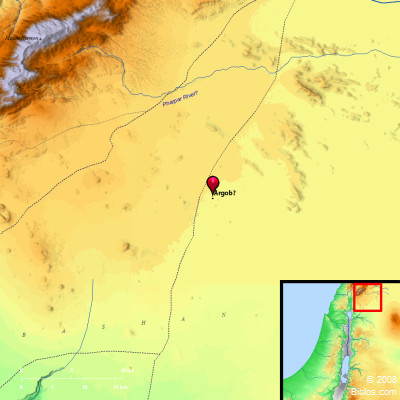Atlas  Argob and surrounding region
Maps Created using Biblemapper 3.0Additional data from OpenBible.infoOccurrences Deuteronomy 3:4 We took all his cities at that time; there was not a city which we didn't take from them; sixty cities, all the region of Argob, the kingdom of Og in Bashan. Deuteronomy 3:13 and the rest of Gilead, and all Bashan, the kingdom of Og, gave I to the half-tribe of Manasseh; all the region of Argob, even all Bashan. (The same is called the land of Rephaim. Deuteronomy 3:14 Jair the son of Manasseh took all the region of Argob, to the border of the Geshurites and the Maacathites, and called them, even Bashan, after his own name, Havvoth Jair, to this day.) 1 Kings 4:13 Ben Geber, in Ramoth Gilead (to him pertained the towns of Jair the son of Manasseh, which are in Gilead; even to him pertained Encyclopedia ARGOB (1)ar'-gob ('argobh, "story"): A locality or a person mentioned in the obscure passage 2 Kings 15:25. The context deals with Pekah's conspiracy against Pekahiah; but it is not clear, owing to the state of the text, whether Argob and his associate Arieh (if these are the names of men) were officers of Pekahiah who were slain with him, or fellow-conspirators with Pekah. The vulg takes them as names of places; they may then be considered glosses that have crept into the text. Rashi holds that Argob was the royal palace. Argob is more likely the name of a place than a person. See ARIEH.
H. J. Wolf ARGOB (2) ar'-gob (ha-'argobh; ha-argobh or Argob): A region East of the Jordan which in Deuteronomy 3:4, 5 is equivalent to the kingdom of Og in Bashan, and in 3:13 is referred to as "all the region of Argob, even all Bashan." Deuteronomy 3:14 is evidently corrupt. Havvoth-jair lay not in Bashan but in Gilead (Judges 10:4 Numbers 32:40 1 Kings 4:13). It contained threescore cities. "All these were cities fortified with high walls, gates and bars; besides the unwalled towns a great many." Deuteronomy 3:14 seems to say that it marched with Geshur and Maacah; but we cannot lay stress on this. We may take it that Argob lay in the land of Bashan; beyond this, on available data, we cannot certainly go.
The word chebhel, translated "region," means primarily a line or cord, then "a measuring line," then "the portion measured," e.g. "the part of the children of Judah" (Joshua 19:9), the "lot" or "portion" of an inheritance (Deuteronomy 32:9 Joshua 17:14, etc.). Chebhel precedes Argob in each of the four cases where it is named. This has led many to think that a district with very clearly marked borders is intended. No region so well meets this condition as el-Leja', a volcanic tract lying about 20 miles South of Damascus, and 30 miles East of the Sea of Galilee. It is roughly triangular in form, with the apex to the North, and is about 25 miles long, with a base of some 20 miles. The lava which has hardened into this confused wilderness of black rock, rent and torn by countless fissures, flowed from the craters whose dark forms are seen on the East.
It rises to an average height of about 20 ft. above the plain, on which it lies like an island on a sea of emerald, the edges being sharply defined. At all points it is difficult of entrance, and might be defended by a few resolute men against an army. To this fact doubtless it owes its name el-Leja', "the refuge." There are many traces of considerable cities in the interior. The present writer collected there the names of no fewer than seventy-one ruined sites. See further TRACHONITIS. This identification is supported by taking 'argobh as the Hebrew equivalent of the Greek trachon, "stony." This is possible only if, as Gesenius assumes, the root raghabh is cognate with ragham, an extremely precarious assumption. "Clod" is the translation of the word reghebh in Job 21:33; Job 38:38; probably therefore 'argobh should be tendered "a region of clods," i.e. "arable land." This practically rules out el-Leja'.
We have seen above that the term chebhel need have no reference to the clearly marked rocky boundaries. As regards the great cities, all Bashan is studded with the ruins of such. The splendid remains that everywhere meet the traveler's eye were thought by Porter (Giant Cities of Bashan) and others, to be the wreck of the great cities that struck the invading Israelites with wonder. It is now clear that the ruins above ground are not older than the beginning of our era. The Greek and Roman architecture is easily recognized. Probably, however, excavation will prove that in very many cases the sites have been occupied from very ancient times. Cave dwellings, chambers cut in the rock and covered with stone vaults, and what may be described as subterranean cities, have been found in different parts, the antiquity of which it is impossible to estimate. There is nothing which enables us to identify the region of Argob. The whole country of Bashan., with the exception of el-Leja', is "arable land." The soil is very fertile, composed of lava detritus. In almost every district might have been found the threescore cities. Guthe suggests the western part of el-Chauran, stretching from Edrei (Der`ah) to Nawa. Buhl would locate it in the district of ec-Cuweit, to the Southeast of the low range of ez-Zumleh. This however seems too far to the South. The Southwest slopes of Jebel ed-Druze seem to meet the conditions as well as any. They form quite a wellmarked district; they are very fertile, and the strong cities in the region must have been numerous.
W. Ewing |




